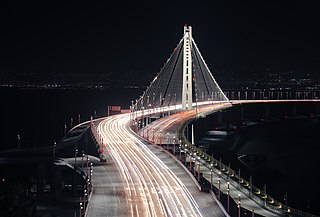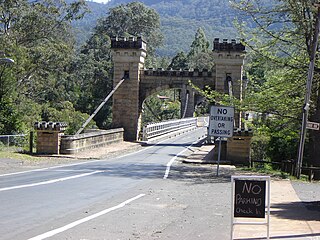
A suspension bridge is a type of bridge in which the deck is hung below suspension cables on vertical suspenders. The first modern examples of this type of bridge were built in the early 1800s. Simple suspension bridges, which lack vertical suspenders, have a long history in many mountainous parts of the world.

A cable-stayed bridge has one or more towers, from which cables support the bridge deck. A distinctive feature are the cables or stays, which run directly from the tower to the deck, normally forming a fan-like pattern or a series of parallel lines. This is in contrast to the modern suspension bridge, where the cables supporting the deck are suspended vertically from the main cable, anchored at both ends of the bridge and running between the towers. The cable-stayed bridge is optimal for spans longer than cantilever bridges and shorter than suspension bridges. This is the range within which cantilever bridges would rapidly grow heavier, and suspension bridge cabling would be more costly.

A self-anchored suspension bridge is a suspension bridge type in which the main cables attach to the ends of the deck, rather than directly to the ground or via large anchorages. The design is well-suited for construction atop elevated piers, or in areas of unstable soils where anchorages would be difficult to construct.

A simple suspension bridge is a primitive type of bridge in which the deck of the bridge lies on two parallel load-bearing cables that are anchored at either end. They have no towers or piers. The cables follow a shallow downward catenary arc which moves in response to dynamic loads on the bridge deck.

The Royal Tweed Bridge, also known as the New Bridge locally, is a road bridge in Berwick-upon-Tweed, Northumberland, England crossing the River Tweed. It was intended to divert traffic from the 17th century Berwick Bridge, and until the 1980s it formed part of the A1 road, the main route from London to Edinburgh. However, the construction of the A1 River Tweed Bridge to the west of Berwick has since reduced the Royal Tweed Bridge's importance.
A suspension bridge supports its structural load with cables, ropes, or chains anchored at each end. Cables on the earliest suspension bridges were anchored in the ground; some modern suspension bridges anchor the cables to the ends of the bridge itself. Earliest suspension bridges had no towers or piers but the majority of larger modern suspension bridges have them. All of the 14 longest bridges in the world are suspension bridges.

The Roberto Clemente Bridge, also known as the Sixth Street Bridge, spans the Allegheny River in downtown Pittsburgh, Pennsylvania, United States.

Hampden Bridge is a heritage-listed single-span suspension bridge that carries Moss Vale Road (B73) across the Kangaroo River, in Kangaroo Valley, in the City of Shoalhaven local government area of New South Wales, Australia. The bridge was designed by Ernest de Burgh and built by Loveridge and Hudson. The property is owned by Transport for NSW. It was added to the New South Wales State Heritage Register on 2 August 2019.

The Waldo–Hancock Bridge was the first long-span suspension bridge erected in Maine, as well as the first permanent bridge across the Penobscot River downstream from Bangor. The name comes from connecting Waldo and Hancock counties. The bridge was built in 1931 and retired in 2006, when the new Penobscot Narrows Bridge was opened just a few yards away, and it was demolished in 2013.

An extradosed bridge employs a structure that combines the main elements of both a prestressed box girder bridge and a cable-stayed bridge. The name comes from the word extrados, the exterior or upper curve of an arch, and refers to how the "stay cables" on an extradosed bridge are not considered as such in the design, but are instead treated as external prestressing tendons deviating upward from the deck. In this concept, they remain part of the main bridge superstructure.
In structural engineering, structural elements are used in structural analysis to split a complex structure into simple elements. Within a structure, an element cannot be broken down (decomposed) into parts of different kinds.

The Flehe Bridge, is a single tower cable stayed bridge located in Düsseldorf, over the Rhine. It connects the A 46 motorway from the left bank of the Rhine with the Bergisches Land on the right bank and the south of Düsseldorf. It forms at the same time the southern part of the ring of motorways around Düsseldorf. It includes a pedestrian and cyclist strip.

Euripus Bridge is a 395-metre-long (1,296 ft) cable-stayed bridge located in Chalcis that crosses the Euripus Strait, the central and narrowest part of the channel separating the island of Euboea from the Greek mainland.
An underspanned suspension bridge is a rare type of suspension bridge that was developed in the early 19th century.

The Jiangyin Yangtze River Bridge is a suspension bridge over the Yangtze River in Jiangsu, China. The bridge has a main span of 1,385 metres (4,544 ft) connects Jiangyin south of the river to Jingjiang to the north. When the bridge was completed in 1999, it was the fourth longest suspension bridge span in the world and the longest in China. Several longer bridges have since been completed in China and abroad, and it is currently the 15th longest suspension bridge in the world. The bridge was also the furthest downstream on the Yangtze until the completion of the Sutong Yangtze River Bridge in 2008 and the Chongming–Qidong Yangtze River Bridge in 2011.

The Port à l'Anglais Bridge is a cable-stayed suspension bridge that spans the Seine river between the French communes Alfortville and Vitry-sur-Seine. It carries two lanes of automobile traffic and has pedestrian walkways on each side.
BBR Construction, BBR System, Bureau BBR, BBR Group or BBR VT International is a Swiss construction firm specializing in cable construction projects such as suspension bridges and tramways. They built the first carbon fibre stay cable bridge. The firm was started in 1944 by three engineers, Max Birkenmaier, Antonio Brandestini and Mirko Robin Ros. Their stay cable technology has been applied to over 400 major structures around the world.

The Black Suspension Bridge spans the Colorado River in the inner canyon of Grand Canyon National Park. The span length is 440 feet (130 m). The bridge is part of the South Kaibab Trail and is the river crossing used by mules going to Phantom Ranch. The Black Bridge and Silver Bridge, located about 700 metres (2,300 ft) downstream, are the only spans in hundreds of river miles.

The Lionel Viera Bridge, also known as the Puente de la Barra and Maldonado Bridge, is a stressed ribbon bridge linking the cities of Punta del Este and La Barra across the Maldonado Creek in southern Uruguay. The bridge is a landmark of both the local beach communities and of Uruguay.

Jürg Conzett is a Swiss civil engineer known for designing bridges. After studying at the ETH Zurich and working for architect Peter Zumthor, Conzett started his own civil engineering office in 1988. Perhaps his best known works are a series of three pedestrian bridges located on the Veia Traversina trail of the Viamala in Switzerland. Though many of Conzett's works are in Switzerland, he has designed bridges elsewhere.


















